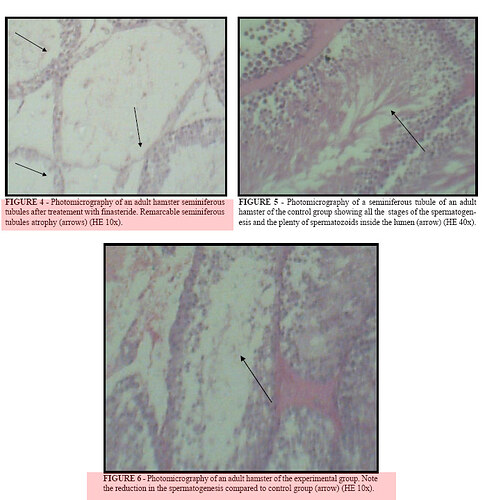Actions of 5a-reductase inhibitors on the epididymis (2006)
FULL PDF:
medicine.mcgill.ca/pharma/ro … 90-195.pdf
Selected bit (Finasteride, rats, dual inhibition of 5AR I and II):
[Size=4]4. Consequences of inhibiting steroid 5a-reductases[/size]
The consequences of inhibiting 5a-reductase activity on
steroid concentrations, gene expression, epididymal epithelial
cell function and sperm maturation have been studied only in
a very limited manner.
Cohen et al. (1981) showed that 5a-
reductase inhibitors (3-oxo-4-androstene-17-carboxylic acid
and its methyl ester) could severely affect the fertilizing ability
of spermatozoa from the cauda epididymides, while Turner and
Futral (1992) showed that the intraluminal androgen balance was
shifted dramatically by 5a-reductase inhibitors.
Studies with
finasteride showed that long-term treatment with a high dose of
the drug resulted in a reversible loss of fertility, but this effect
was ascribed to the action of the drug on the secretions of sex
accessory tissues, reducing the formation of copulatory plugs,
not on the epididymis, although effects on the histology of the
epididymis were not reported and embryonic development was not allowed to progress beyond its very early phases (Cukierski
et al., 1991; Wise et al., 1991).
With the discovery that PNU157706 is a potent inhibitor of
both isozymes of 5a-reductase, di Salle et al. (1998) showed, for
the first time, that inhibition of 5a-reductases results in a reduction
in epididymal weight.
An investigation of the consequences
of inhibiting both isozymes of 5a-reductase on gene expression
profiling along the epididymis was undertaken in order to
determine whether reduction of DHT production would have
selective actions (Henderson et al., 2004).
The effect of treatment
with this drug on gene expression was dose-dependent and
highly segment-specific; the initial segment responded uniquely
in that a similar number of genes increased and decreased in
expression, compared to the other segments where the majority
of affected genes decreased in expression.
Some of the more
dramatically affected genes were involved in signal transduction
as well as fatty acid and lipid metabolism, regulation of
ion and fluid transport, luminal acidification, oxidative defense,
and protein processing and degradation.
These are essential
processes, contributing to the formation of an optimal luminal
microenvironment, as required for proper sperm maturation.
The consequences of inhibiting both isoforms of 5a-
reductase (types 1 and 2) on epididymal sperm maturation were
examined by treating rats with PNU157706 and analyzing fertility
as well as several key facets of sperm maturation.
The
motility of spermatozoa from the cauda epididymides of treated
animals showed a significant decrease in both the percentage of
motile and progressively motile sperm as well as altered motion
parameters.
The morphology of cauda epididymal spermatozoa
was also adversely affected by the treatment; the most prominent
effect was a markedly elevated proportion of sperm that retained
their cytoplasmic droplet.
Mating control females with treated
males resulted in fewer successful pregnancies and a higher rate
of pre-implantation loss. Surviving progeny were unaffected.The compromised sperm motility and morphology likely contribute
to the subfertility of inhibitor-treated rats (Henderson
and Robaire, 2005).
These results indicate a role for dual 5a-
reductase inhibitors in further studies of epididymal physiology
and as a potential component of a male contraceptive.
Actions of 5a-reductase inhibitors on the epididymis.pdf (241 KB)




